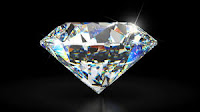If you hit a diamond with a hammer, it’ll shatter into a dozen pieces. If you hit a piece of quartz with a hammer, it’ll split in two. If you hit a piece of jade with a hammer, it’ll ring like a bell!
That's an old jeweler's saying. We all know that diamonds are the hardest gemstones. So can a genuine diamond really shatter? What if it's dropped onto the floor? What about other gemstones?
I read in the Amazon forums that a buyer felt that their gemstone necklace was "fake" because the stone broke when she dropped it onto her tile floor! She felt that only something that was glass would break from dropping it onto a hard floor. She expected a refund, and the jewelry seller sought advice from other Amazon sellers, most of whom aren't jewelers. Some of the responses were in favor of the buyer (they "didn't know if genuine gems would ever break"), and others in favor of the seller. So I thought I'd write about gemstones, their hardness, and their wearability.
==============================
OVERALL DURABILITY OF GEMS
The "hardness" of a gem is only one factor in determining a gemstone's durability. Gemologists take into consideration other factors: ability to withstand heat, light, chemical exposure (household cleaners etc.), and humidity, stone treatments, gem cleavage, and even the cut of a gem. So gemstones are evaluated by (1) hardness; (2) toughness; and (3) stability. All of these factors should be weighed when deciding which gemstone is right for you.
WHAT IS GEMSTONE HARDNESS?
This is a really misunderstood and confusing term. In gemology, the word "hardness" has a different meaning---it simply means the ability to resist scratches and abrasions, and nothing more! So really the hardness of a gem is measured by its "scratchability".
In the early 1900s, Freidrich Mohs developed a scale from 1-10 to describe minerals' ability to be scratched, with 1 being the softest and 10 the hardest. This is known as the Mohs Scale of Hardness. All gems are rated between 1-10 but the Mohs scale uses the following gems as an example:
 |
| Quartz Geode |
Each one of these minerals can scratch the one below it, and can be scratched by the one above it. And the scale isn't linear, but is relative----Corundum (9) is twice as hard as topaz (8), and diamond (10) is four times as hard as corundum. And with the mineral Kyanite, the hardness can vary within one crystal from 4 to 7.5!
There are also many minerals that are rated halfway between numbers, such as tourmaline which can range from 7.0 to 7.5.
GEMSTONE TOUGHNESS
This is the ability of a gem to resist breaking and chipping.
 |
| Nephrite Jade--VERY Tough! |
Gems softer than Quartz (7) will lose their polish just from simply cleaning it over time. Gems with a Mohs rating of 7 and up are considered very wearable a suitable for everyday wear. Wearability is graded as Excellent, Very Good, Good, and Poor. Opals have a "Poor" wearability rating, which means it should be saved for special occasions or set in protective settings.
 |
| Opals--3% to 21% Water! |
So.....a gemstone's "durability" is a function of its resistance to scratches (hardness) + resistance to breakage (toughness) + other special properties such as cleavage planes (or in the case of jade that "rings like a bell" mentioned at the top---an interlocking structure that makes it very tough.) Certain gemstone cuts, like marquise, are more prone to chipping, as are gems that are loose in their settings.
GEMSTONE STABILITY
Just because a gem is hard doesn't always mean its wearability is "excellent." Some gems are sensitive to chemicals, temperature changes, or even sweat!
 |
| Diamond cracked by thermal shock |
Some gems are vulnerable to humidity changes. Opals can lose their moisture in dry conditions and crack. Some gems can absorb water---malachite, amber and azurite.
 |
| Citrine, Amethyst, Prasiolite |
Chlorine and perfumes and makeup are chemicals that can also damage or discolor some gems, such as pearls. Chlorine can also damage gold mountings! Ammonia will damage the shine on turquoise, malachite, and coral. Turquoise can easily absorb all sorts of oils and chemicals.
GEMSTONE TREATMENTS
 |
| Fracture-Filled Emerald |
CONCLUSION
Gemstone hardness alone isn't a measure of a gem's toughness or wearability. There are many other factors to determine how well a particular gem will wear over time.
So regarding that woman's assertion that "only a fake gem would break"--- she is WRONG. Any gemstone can break when dropped onto a hard surface like a tile floor, including a diamond. Some manmade stones, such as the Cubic Zirconia with a Mohs hardness of 8 or 8.5 or Moissanite with a Mohs hardness of 9.25, will resist scratches and chips better than most other gemstones.
Most gemologists or great websites such as the GIA will list each gemstone's Mohs rating, plus wearability grades.
It's important to always treat your gemstone jewelry with care---don't drop it, bump it, or wear while swimming or doing housework or working around chemicals. Keep jewelry clean and safe while not wearing it. Keep your jewelry in a jewelry box, away from other pieces of jewelry so they don't bump each other. Make sure any prongs are secure and stones aren't loose. This will ensure that your fine jewelry will remain beautiful and last for generations.









